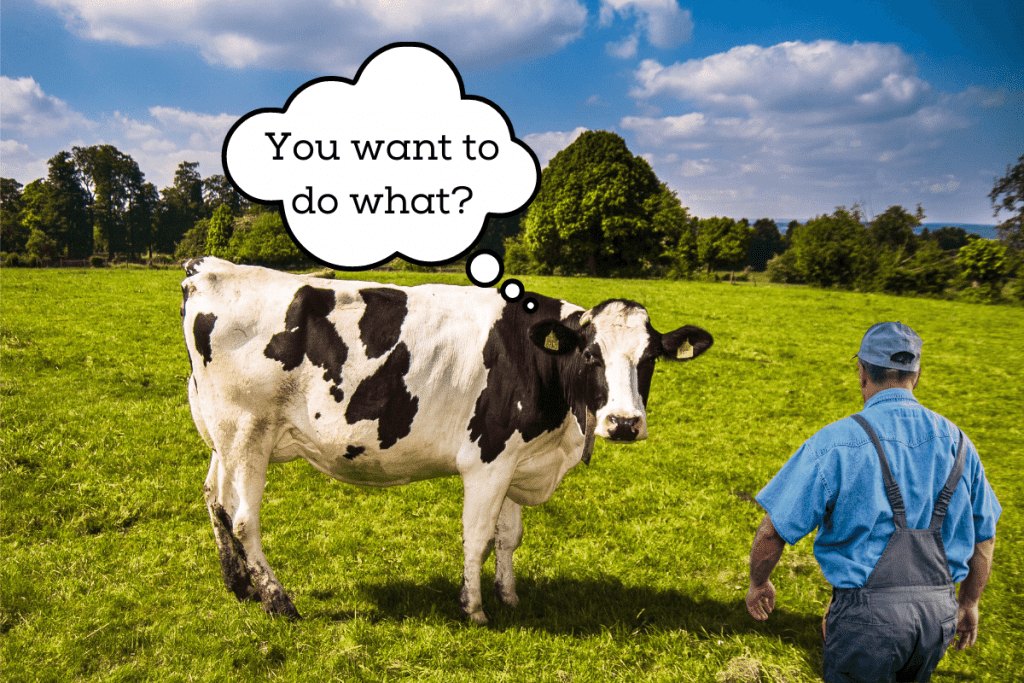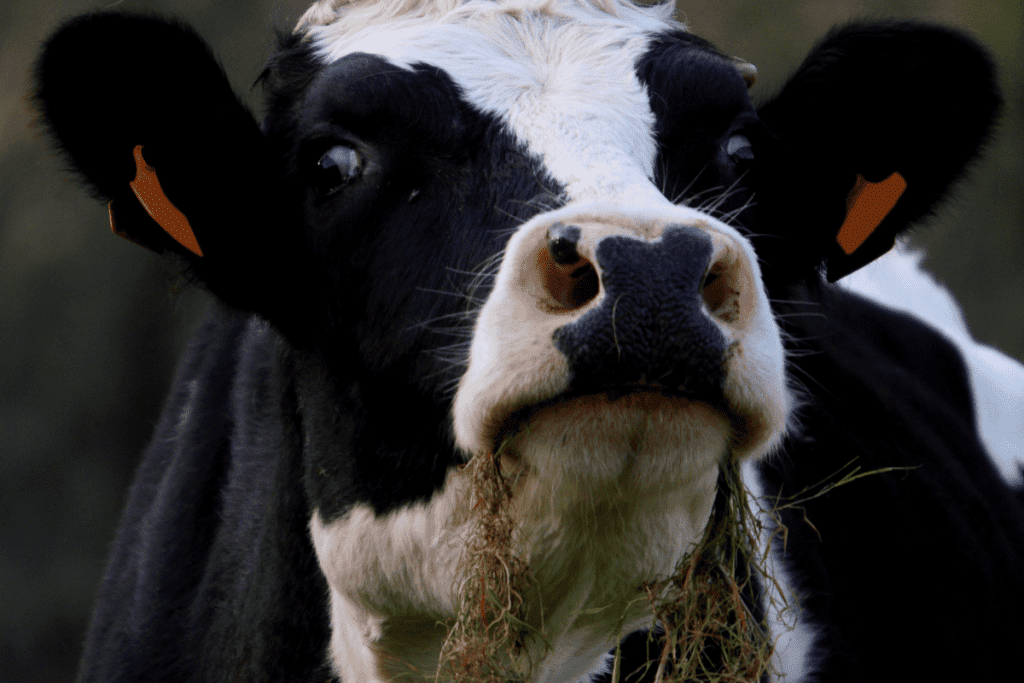Cattle are commonly raised on farms for various purposes, including dairy and meat production.
Some cows are used as breeding stock, and their offspring are sold on the market for profit.
Oxen are trained as working animals used for pulling carts, plows, and sleds.
Cows have multiple uses on a working farm, but is it possible to ride them?
Riding a cow is possible as long as the animal has been properly trained. However, riding a cow is generally not recommended due to safety concerns for both the cow and the rider. Cows are not naturally made for riding, and doing so will cause their hooves to wear down faster than normal.
If a cow is not trained to be ridden, the animal may be easily frightened and throw the rider off its back.
Keep reading for more information about riding cows, including training and safety concerns.

Table of Contents
ToggleCan You Ride Cows?
Yes, it is possible to ride a cow, but there are a few factors to consider beforehand.
Riding a cow is an unusual choice when other riding animals, such as horses or mules, are available.
Since cows are not inherently made for riding, they require prolonged training to do so.
The cow’s temperament chosen for riding is very important, as an aggressive animal is more likely to put the rider at risk for injury.
Cows are also not as responsive to instruction in the same way as horses, mules, and other riding animals.
While you may have a specific destination in mind, the cow will have other ideas, frequently stopping to graze or observe its surroundings.
Before training a cow for riding, you also need to consider the animal’s age and size.
A younger calf will be easier to train, but it is also important for the cow to be large enough to support the weight of a rider comfortably.
If you do not have cows of your own, several farms allow you to ride a cow.
At the Bolderhof Farm in Switzerland, they began offering cow rides in 2017 to tour the Swiss Alps.
You may choose between an hour-and-a-half ride or a four-hour trip through the Alpine terrain.
How Much Weight Can Cows Carry?
Adult cows can carry up to 50% of their body weight as a general rule.
Calves are only able to carry between 35%-40% of their body weight.
The weight of a cow will depend on its breed, sex, age, diet, and what it is being raised for.
On average, adult cows weigh between 800-1,400 pounds, with some large breeds weighing more than 3,000 pounds.
Male cows usually weigh more than females because they have more muscle mass.
Cows reach their adult weight when they are around two years old.
A nutrient-rich diet of corn, oats, barley, and soy, will cause a cow to gain weight more quickly when compared to a low-nutrient grass-only diet.
Related: Can cattle safely eat deer corn?
Dairy cattle tend to weigh less than beef cattle because most energy resources focus on milk production.
It is best to wait to ride a cow until at least one year old to ensure the animal is large enough.
Riding a cow when it is too small to handle your weight will cause its back to become injured.
Do Cows Like To Be Ridden?

Whether or not cows like to be ridden is a highly debated topic.
Cows will usually object to having a person on their back at first, but once they are properly trained for a bit of time, they do not seem to mind it much.
However, just because the cow no longer puts up a fight, it does not mean the animal enjoys having a rider.
Some animal welfare advocates believe riding a cow is cruel, as the poor animal is not made for giving rides.
Riding a cow will cause its hooves to wear down quickly, and they will need to be fitted with shoes first.
Shoeing a cow is a more difficult process than horses, and the practice is usually reserved for working animals such as oxen.
Cows will not readily stand on three legs as horses will, and shoeing them requires a special harness to support them.
It is also more expensive and time-consuming to shoe a cow since its cloven hoofs require two shoes on each foot instead of one.
Still, others say that as long as the cow is shoed correctly, the weight requirements are considered, and the animal is only ridden for short periods, it is perfectly safe.
Can You Ride An Ox?
Riding an ox is not much different than riding a cow.
In fact, in many Asian countries, riding oxen is very common since these animals are widely used for farm work.
Oxen are often confused for bulls because of their similar traits, but they are a sub-genus of cattle.
The ox is much larger than a typical bull, has longer horns, and may be male or female, whereas a bull only refers to a male cow.
It is more common for an ox to be a male, and once the animal is castrated, it is often referred to as a steer.
There are several associations worldwide committed to educating others about riding steers and celebrating the animals.
Check out our definitive answer to the difference between cow, bull, cattle, and oxen.
What Types Of Cows Can You Ride?
Any cow may be trained for riding as long as the animal is sturdy enough.
The most common cow for riding is the Texas Longhorn, and there are more than 400 saddle-trained Longhorn steers in the United States.
Highland cows are very similar to Longhorns, and they are also used for riding.
While Longhorn and Highland cows appear intimidating because of their long horns, they are very docile and friendly cattle breeds.
Zebu cattle, a bovine subspecies, originate in South Asia and are frequently used as transportation there.
Since dairy cows are smaller, they do not have the strength to carry people and should not be used for riding purposes.
Dairy cattle also have more prominent spines than other cows, and they are not comfortable riding.
Bulls are not suitable for riding because they are not castrated, making them more aggressive and difficult to control.
Is Riding A Cow Like Riding A Horse?
A cow ride is much different from a horse ride in various ways.
Having prior experience with riding a horse will make learning to ride a cow much easier, but you will still need to make some adjustments.
The wider stance required to straddle a cow will be more tiring to your body.
Cows are much slower and less agile than horses, and they cannot handle rivers or other obstacles.
However, cows can handle steeper inclines, and their slower speed gives them more stability and better endurance than horses.
Even though cows have strong endurance, it is best to keep riding sessions short to avoid causing any strain on the animal.
Cows also tend to be hardier than horses, and they recover more easily from minor injuries.
If the cow has large horns, it may be dangerous to the rider if the animal is frightened or angered.
While cows generally have a calm temperament compared to horses, they are prey animals, and they may be scared easily by a predator.
As previously stated, it is also more difficult to steer a cow in the direction you would like to go, and due to their slow movement, your journey will take much longer than it would with a horse.
How Can You Train A Cow To Give Rides?
There are no professional training schools for riding cows, so you will have to do the training yourself.
Patience is key with training a cow for riding since the process will last for several months.
You will start by choosing the most gentle calf in the herd.
It is much easier to train a calf than an adult cow, and you will need to form a strong bond with the animal by offering treats and spending lots of time together.
Move your hands along the cow’s back to get it used to your touch.
Once the cow is no longer startled by your touch, apply gentle pressure to its back and repeat this step for at least one week.
When you have earned the cow’s trust, you will be able to gently climb onto the animal’s back, sit for a few seconds, and then come down.
Repeat this process for several weeks until the cow seems comfortable with you sitting on its back.
To steer the cow, you will need to teach the animal to respond to reins.
It is best to do this part of the training in a smaller enclosed area with fewer distractions.
After placing the reins on the cow, climb back and pull the rein either left or right.
You will have to be very patient and repeat this step for several training sessions until the cow responds to the direction you are pulling the reins.
Take the animal for a ride when the cow is comfortable with you and consistently responds to the reins.
Be sure the area you ride is free from obstacles and distractions for the best experience for you and the cow.
How useful was this post?
Click on a star to rate it!
We are sorry that this post was not useful for you!
Let us improve this post!
Tell us how we can improve this post?
